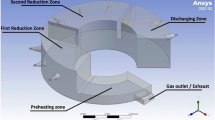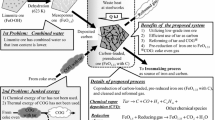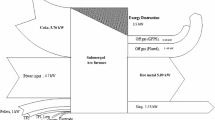Abstract
A new prospective in the Egyptian steelmaking industry using pure hydrogen to reduce waste iron ores in a two-stage fluidized bed reactor through direct reduction process is presented, modeled, and analyzed. The main advantage of applying this route to the steel industry is the enormous reduction in CO2 emissions compared to today's dominant routes that rely on the blast furnace—basic oxygen furnace (BF/BOF). Moreover, the hydrogen direct reduction (H-DR) process could be directly applied for the reuse of the waste imported lump iron ores that are been crashed during the transportation process to a small fines particles; making them unusable in blast furnace processes unless sintering process is applied. A complete study to verify the applicability of this idea in Egypt has been investigated and comparing it to current fluidized bed reactor using syngas as the reducing agent.
Access provided by Autonomous University of Puebla. Download conference paper PDF
Similar content being viewed by others
Keywords
- Egyptian steelmaking industry
- Direct reduction process
- CO2 emissions
- Blast furnace—basic oxygen furnace
- Waste imported lump iron ores
Introduction
The world needs to find a way to make lots of steel while reducing the industry’s carbon footprint. The Paris Agreement implies that all industrial sectors must reach zero emissions by 2060–2080, while the European Union seeks to achieve a 80–95% reduction of greenhouse gases by 2050 compared to 1990 [1]. And the UK government’s independent Climate Change Committee has recommended that steelmaking should reach near zero carbon emissions by 2035. Therefore, Egyptian steelmaking industry should take some serious steps in achieving this target. There are five integrated steel companies in Egypt; the Egyptian iron and steel company Hadisolb in El-Tabbin, EZDK Company in Alexandria, Bishay steel company in El-Sadat city, EZ steel company in Suez, and Suez Company for steel production (El-Garhi MF) in El-Ain El-Sokhna. Among these five integrated companies the Egyptian iron and steel company, i.e., Hadisolb is the only one who adopts the blast furnace route. It is also the only company in Egypt, which has a sintering plant and uses local iron ores to produce pig iron in which Coke reduces the ore to iron in a blast furnace by reacting with oxygen to make carbon monoxide. One molecule of iron ore reacts with three molecules of carbon monoxide, leaving two iron atoms and three molecules of carbon dioxide. The other four integrated companies adopt either MIDREX technology or Danieli's HYL-ENERGERON technology that initiate with the natural gas DR route in which a mixture of carbon monoxide and hydrogen is used as the reductant of highly rich imported iron oxide pellets to produce sponge iron [2]. This route, compared to the blast furnace route, is 50% in CO2 emissions. Yet a complete hydrogen-based route can reach far lower levels from 89 to 99% reduction in CO2 emissions [3].
Discussion
As long as the four companies are producing sponge iron according to their designed capacities and so far as natural gas is available, about one million tons of highly rich iron oxide wastes almost free from Cl and MnO will be annually available as well. The following Table 1 illustrates the chemical composition of the highly rich iron oxide by-products and their annual production in EZDK Company in year 2015 [2].
These iron oxide wastes cannot be reused in their own plants as their particle sizes are not suitable any more for natural gas DR route of either MIDREX which treat iron ore pellets of size 9–16 mm and can accept only 5% from the feed to be from the size 5–9 mm or HYL ENERGEON that treat Iron ore pellets of size greater than 5 mm [4]. Thus any iron ore with particle size lower than 5 mm is considered to be a waste. These wastes are been exported abroad; moreover, for instance EZDK gives these wastes to Hadisolb and getting instead the equivalent weight of pig iron. As Hadisolb has a sintering plant which convert these fines into sinters that afterward undergoes blast furnace route iron making. However, according to the new prospective of reducing the CO2 emissions in steel industry, this process is considered a delaying step toward achieving the environmental target. Therefore, a promising alternative is been recommended in which these iron fine wastes could be considered a direct feedstock without prior agglomeration or sintering for a hydrogen-based direct reduction steelmaking process using Circored® technology, in which iron ore fines are directly reduced in a two-stage fluidized bed process that operates at low reduction temperatures using pure hydrogen as the reducing gas [5]. This route if applied will be the first in Egypt that is responsible for direct reduction of iron fines as the current direct reduction plants can only deal with either lump iron ores or pellets ores. Moreover, it will be the first in Egypt to use a complete hydrogen-based direct reduction process. Not as the current direct reduction plants that relies on reformed natural gas as the reductant agent [6].
The New Proposed Steelmaking Route
The first process of the route is the production of hydrogen by water electrolysis using CO2-lean electricity. The challenge is to achieve massive production of H2 in acceptable economic conditions [7]. The second process is the direct reduction of iron fines in a first reduction stage which is a circulating fluidized bed (CFB), then following a second reduction stage which is fluidized bed (FB) reactor operated with hydrogen only. The third process is the melting of the carbon-free direct reduced iron in an electric arc furnace to produce steel. The following Fig. 1 illustrates the hydrogen-based route for direct reduction of lump iron ores or pellets using the reduction shaft reactor of either MIDREX or HYL/Energiron (the left side of the figure); however, the hydrogen-based route for direct reduction of lump iron fines using fluidized bed reactors of Circored (the right side of the figure).
Conclusion
Steelmaking is one of the sectors contributing the most to the global greenhouse gas emissions; it is imperative to find a low-carbon process to keep global warming below 1.5 °C. There is a critical need to find new, low-carbon solutions for iron ore reduction. Hydrogen-based direct reduction is one of several promising options. A new prospective in the Egyptian steelmaking industry using pure hydrogen to reduce waste iron ore fines in a two-stage fluidized bed reactor through direct reduction process is presented, modeled, and analyzed [8]. The main advantage of applying this route to the steel industry is the enormous reduction in CO2 emissions compared to today's dominant routes that rely on either the blast furnace—basic oxygen furnace (BF/BOF) or the reformed natural gas direct reduction route of MIDREX or HYL/Energiron technology. However, the hydrogen direct reduction (H-DR)—electric arc furnace (EAF) process using Circored technology could be directly the suitable solution for the reuse of the waste imported iron ore fines in Egypt that are in the current time either exported or exist as a feedstock for a blast furnace route after a sintering process is applied. A complete design to the process is to be proposed to verify the entitlement of applying this route in Egypt as it is a promising alternative for recycling these waste iron ore fines and producing liquid steel with very blameless environmental standings.
References
Vogl V, Åhman M, Nilsson LJ (2018) Assessment of hydrogen direct reduction for fossil-free steelmaking. J Clean Prod 203:736–745. https://doi.org/10.1016/j.jclepro.2018.08.279
Rassoul EMA, Galal AM, AbdelRassoul R (2019) The re-use of highly rich iron oxide wastes from integrated Dr steel companies in Egypt. https://www.researchgate.net/publication/335775022_THE_RE-USE_OF_HIGHLY_RICH_IRON_OXIDE_WASTES_FROM_INTEGRATED_DR_STEEL_COMPANIES_IN_EGYPT. Accessed Sep 06 2021
Patisson F, Mirgaux O (2020) Hydrogen ironmaking: how it works. Metals (Basel) 10(7):1–15. https://doi.org/10.3390/met10070922
Parisi DR, Laborde MA (2004) Modeling of counter current moving bed gas-solid reactor used in direct reduction of iron ore. Chem Eng J 104(1–3):35–43. https://doi.org/10.1016/j.cej.2004.08.001
Circored hydrogen-based reduction—Metso Outotec. https://www.mogroup.com/portfolio/circored-hydrogen-based-reduction/. Accessed 13 July 2021
MIDREX (2013) World direct reduction statistics. Midrex Technologies, Inc., p 14
Ranzani Da Costa A, Wagner D, Patisson F (2013) Modelling a new, low CO2 emissions, hydrogen steelmaking process. J Clean Prod 46:27–35. https://doi.org/10.1016/j.jclepro.2012.07.045
Kinaci ME, Lichtenegger T, Schneiderbauer S (2020) A CFD-DEM model for the simulation of direct reduction of iron-ore in fluidized beds. Chem Eng Sci 227. https://doi.org/10.1016/j.ces.2020.115858
Author information
Authors and Affiliations
Corresponding author
Editor information
Editors and Affiliations
Rights and permissions
Copyright information
© 2022 The Minerals, Metals & Materials Society
About this paper
Cite this paper
Abouseada, A.A., Hatem, T.M. (2022). Iron-Ore Reduction Using Green Hydrogen: A Study for Recycling Wastes in Egyptian Steel Industry. In: Lazou, A., Daehn, K., Fleuriault, C., Gökelma, M., Olivetti, E., Meskers, C. (eds) REWAS 2022: Developing Tomorrow’s Technical Cycles (Volume I). The Minerals, Metals & Materials Series. Springer, Cham. https://doi.org/10.1007/978-3-030-92563-5_64
Download citation
DOI: https://doi.org/10.1007/978-3-030-92563-5_64
Published:
Publisher Name: Springer, Cham
Print ISBN: 978-3-030-92562-8
Online ISBN: 978-3-030-92563-5
eBook Packages: Chemistry and Materials ScienceChemistry and Material Science (R0)





